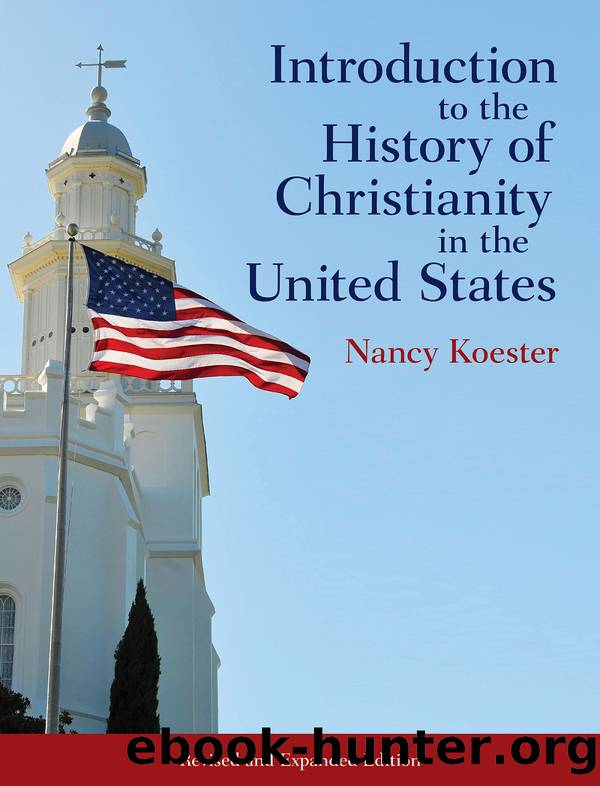Introduction to the History of Christianity in the United States by Koester Nancy

Author:Koester, Nancy
Language: eng
Format: epub
Tags: United States--Church history.
Publisher: Minneapolis, MN
Published: 2015-07-14T16:00:00+00:00
Box 5.5: Native American Church
Source: Oklahoma Historical Society, Encylopedia of Oklahoma History and Culture, http://digital.library.okstate.edu/encyclopedia/entries/N/NA015.html.
In the 1870s a new religion based on the ritual consumption of peyote formed on the reservations of southwestern Indian Territory, present-day Oklahoma. Lophophora williamsii is a small, spineless cactus that grows on the caliche-rich bluffs of the Rio Grande Valley in Texas and throughout the northern plains of Mexico. Called peyote, from the Aztec word peyotl, it has been used as a physical and spiritual medicine by the Indians of the Americas for thousands of years. The structure and content of Peyotism drew upon earlier ceremonies from northern Mexico and traditional theologies from the southern Plains cultures.
In the early 1880s the ceremony, ritual instruments, and core doctrine of the modern peyote religion became more uniform, and the religion spread to other tribes within Indian Territory. By 1907 statehood, Peyotism’s spread to the majority of Oklahoma tribes had been greatly facilitated by established patterns of intertribal visiting and intermarriage. On October 10, 1918, an intertribal coalition of Peyotists achieved legal definition for their religion through the incorporation of the Native American Church of Oklahoma.
The individual most closely associated with the early history of Peyotism is Quanah Parker (Comanche). Other Oklahomans figuring prominently in the development and diffusion of the religion include Chivato (Lipan), Jim Aton (Kiowa), John Wilson (Caddo-Delaware), and Jonathan Koshiway (Oto). Numerous others, most of whom received no formal recognition, played important roles in the introduction and adoption of the Native American Church throughout the Western Hemisphere.
Much of the theological interpretation and spiritual belief of the Native American Church is highly individualized, with the conservative ritual providing a sacred setting for personal introspection and meditation. A basic creed of reverence for universal nature and the tenets of “faith, hope, love and charity” characterize the collective doctrine. The Native American Church is a religion of diffusion that accommodates a wide range of local traditions and practices. Congregations and even individual members incorporate differing degrees of Christian theology and Indian symbolism in their practice of Peyotism.
The ritual setting for Native American Church ceremonies, or “meetings,” as members refer to them, is generally a tipi erected for the purpose of the service. A crescent-shaped altar is constructed of clean soil in the center of the tipi, with the crescent opening to the east. The religious service consists of an all-night ceremony that includes a ritually maintained fire, rounds of individual singing, prayers, and the use of peyote as a holy sacrament. Individuals referred to as “roadmen,” who are well experienced in the ceremonies of the church and respected members of their communities, lead the religious services.
Typical reasons for holding services of the Native American Church include the desire to cure illness, to celebrate birthdays, Christian holidays, New Year’s Day, Veterans Day, and entrance into and graduation from school, and to commemorate funerals, marriages, and any other significant events in the lives of the participants. A stated purpose is not required to hold a church service, and many
Download
This site does not store any files on its server. We only index and link to content provided by other sites. Please contact the content providers to delete copyright contents if any and email us, we'll remove relevant links or contents immediately.
The Gnostic Gospels by Pagels Elaine(2470)
Jesus by Paul Johnson(2310)
Devil, The by Almond Philip C(2281)
The Nativity by Geza Vermes(2180)
The Psychedelic Gospels: The Secret History of Hallucinogens in Christianity by Jerry B. Brown(2121)
Forensics by Val McDermid(2043)
Going Clear: Scientology, Hollywood, and the Prison of Belief by Lawrence Wright(1937)
Going Clear by Lawrence Wright(1922)
Barking to the Choir by Gregory Boyle(1786)
Old Testament History by John H. Sailhamer(1768)
Augustine: Conversions to Confessions by Robin Lane Fox(1736)
The Early Centuries - Byzantium 01 by John Julius Norwich(1700)
A History of the Franks by Gregory of Tours(1682)
A Prophet with Honor by William C. Martin(1682)
Dark Mysteries of the Vatican by H. Paul Jeffers(1674)
The Bible Doesn't Say That by Dr. Joel M. Hoffman(1652)
by Christianity & Islam(1594)
The First Crusade by Thomas Asbridge(1575)
The Amish by Steven M. Nolt(1530)
